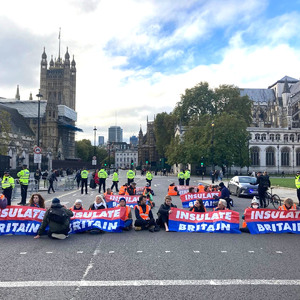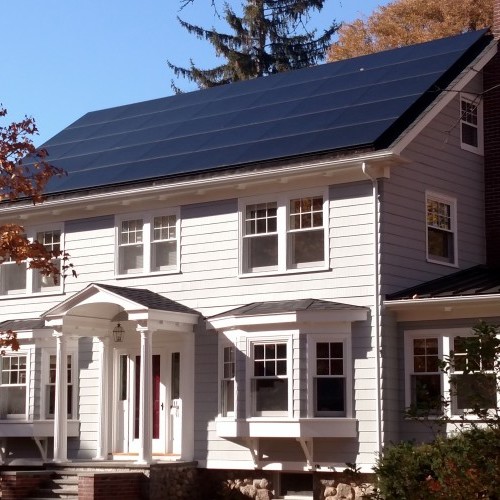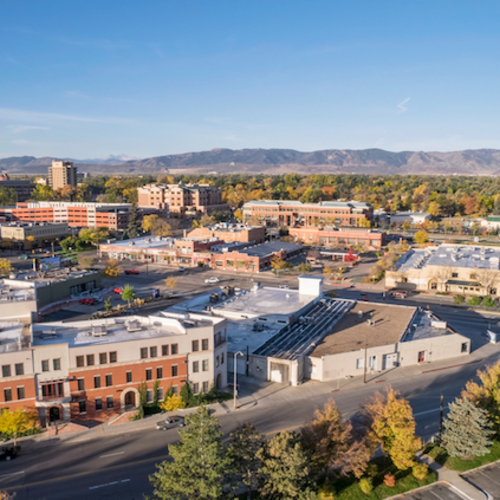Image Credit: Transition Zero
Image Credit: Transition Zero A completed home should be able to hit net-zero energy performance without costing its owners any more. The Transition Zero project is designed so that savings from lower energy consumption pay for the upgrades.
Thousands of European families are now living in comfortable, energy-efficient homes that were upgraded in a far-reaching program called Transition Zero, all part of an effort to lower carbon emissions in the European Union.
Starting in 2010 with a €40 million grant from the Dutch government, a non-profit group called Energiesprong worked with builders to develop a method for upgrading ordinary houses into net-zero-energy performers with prefabricated building components. The process took weeks, not months, and was designed to be a financial wash for tenants — the cost of the upgrades could be financed by the savings in lower energy bills
A group of advocates for high-performance buildings hopes a similar model can be successful on this side of the Atlantic. Working with a three-year $500,000 grant from the Department of Energy, a group calling itself REALIZE is adapting the Energiesprong approach to the U.S. housing market and hopes to have a pilot conversion completed by the middle of 2020.
The effort brings together three organizations with deep roots in the high-performance building arena: the Rocky Mountain Institute, the Net-Zero Energy Coalition, and the Passive House Institute U.S. Together, they hope to overcome a variety of obstacles that have so far prevented a “mass-scale” approach to building upgrades and limited documented net-zero retrofits in the U.S. to just 31.
“The task at hand is to design a replicable system that we can test on a pilot building in a cold climate zone in the U.S.,” Net-Zero Energy Coalition Executive Director Shilpa Sankaran said by telephone.
Separately, the New York State Energy Research and Development Authority has issued a request for proposals from those interested in developing an Energiesprong-style building rehab program there called RetrofitNY. As much as $450,000 is available, and applications will be accepted through July 31.
RetrofitNY was announced by New York Governor Andrew Cuomo in February. He called it a first for the U.S. and said the state would set aside $30 million over 10 years to bring a “substantial portion of New York’s affordable housing units to or near net-zero energy over the next decade.”
How the retrofits are carried out
The key to the residential overhauls in the Netherlands is the use of prefabricated building components to carry out a retrofit in only a few weeks, without disrupting the lives of tenants. Builders use what Energiesprong describes as a “3-D scanning technique” to make roof and wall panels that will become a new enclosure for an existing house.
Components can be manufactured accurately and quickly. The panels arrive on the site already insulated, and with wiring and duct work installed. Wall sections are moved by crane and bolted to brackets that have been attached to the house. Houses typically get a new bathroom and kitchen, and the all-electric houses are powered by a 6-kW photovoltaic system on the roof.
Homeowners can stay in the house through much (but not all) of the process, and in the end should be able to pay for the €40,000 targeted cost by reducing electricity use by some 15,000 kWh per year. When GBA first reported on Transition Zero in 2014, work was being carried out on “social housing,” government-financed row houses for middle-class and low-income tenants.
Transition Zero hoped to expand the program to include 110,000 homes in the Netherlands alone. According to the Energiesprong website, it has since expanded into Germany, the United Kingdom, and France. In time, the net-zero conversions, if carried out on enough housing stock, could help the EU meet its carbon emissions reduction target of 80% by the middle of this century.
Progress here to date
The group in the U.S. is in the early stages of developing a similar program. After a number of preliminary steps this year and next, REALIZE is shooting for a pilot construction project somewhere in the U.S. by the second quarter of 2020.Sankaran said the likely target will be a multifamily affordable housing project of between 30 and 50 units in a mid-sized to larger city.
Details on how the retrofits will be carried out are still to be decided, including how and where the building components will be assembled. At the moment, it’s just too soon to tell what a proposed building package would look like, and there’s no guarantee it will be an exact copy of the Dutch model, Sankaran said.
“We’re open to whatever the best, scalable, affordable, prepackaged solution is,” she said. “We are trying to replicate the model, not the specific technology.”
That said, Sankaran believes the approach probably will mimic the Transition Zero model in that existing buildings will be wrapped in a new exterior. REALIZE is in the process of selecting its engineering/design partner, and by the end of the year should have selected the specific building for the pilot study. Net-zero energy operation is the goal, but it remains to be seen how much on-site energy can be produced by a multifamily building in an urban environment.
The target could be a privately owned, affordable housing project, Sankaran said. Tenants would not see their rents increase because they are controlled by federal regulations, but the building owner could see financial benefits from the upgrades that would allow them to build more affordable housing projects.
“When they can leverage their debt capacity, it allows them to do more projects,” she said. “That’s some of the intricate math that we’re working through right now.”
PHIUS executive director Katrin Klingenberg said by telephone that the Rocky Mountain Institute organized a series of meetings three years ago to test interest in the idea of importing the Energiesprong model into the U.S. PHIUS was a good fit, she said, because the project faced some of the same issues that a transfer of Passivhaus building principles did: How to get a standardized building approach to work in a place with many different climate zones?
Why net-zero progress is slow
Net-zero buildings are still a relative rarity in the U.S. The Net-Zero Energy Coalition’s inventory of houses currently operating at that level in the U.S. and Canada stands at 5,593. Citing data from the Thousand Home Challenge, the group reports that to date only 31 zero-energy retrofits have been documented in the U.S.
REALIZE says this is due to several “legacy issues” in the housing industry, including:
- Lack of industry knowledge on how to design and carry out a net-zero retrofit.
- A fragmented and complex construction process.
- A “lack of industry ambition” to develop techniques that could be used on a mass scale.
- Uncertainty among building owners on a return on investment for a retrofit.
REALIZE sees the program developed by Energiesprong as a way of circumventing those problems. In the end, the U.S. program should be able to deliver high-performance homes in two weeks that come with performance guarantees and are paid for with energy savings.
“This model employs a process that combines aggregation of demand with a coordinated supply chain to deploy prefabricated, mass-scale retrofits,” a statement said. “Think of it like an IKEA net-zero-energy retrofit!”
Can the U.S. approach be as successful as Energiesprong? Klingenberg thinks so, and the focus here on multifamily buildings rather than small townhouses common to European cities will be important.
“We’re looking at multifamily projects with a much larger scale impact,” she said. “If and when we get that solution together and have a typology that is very widely existing in the market, I think at that point we can scale up very quickly. That’s RMI’s goal: Getting to the retrofit market and accessing it for climate action. We can’t just rely on the new construction side. We’re not going to make a dent regarding climate. We really need to get to these larger scale multifamily projects.”
In New York, carbon goals also a factor
As is the case with the European Union, RetrofitNY is designed to lower greenhouse gas emissions. The state hopes to cut emissions by 40% by 2030.
Design/construction teams are being asked to come up with plans to retrofit as many as six multifamily projects across New York. NYSERDA said design solutions would be required to exclude fossil fuels on site, to be cost-effective, and “be standardized, scalable, and aesthetically pleasing.” In other words, the same list of objectives that REALIZE is working with.
The announcement said that NYSERDA views the RFP as a first step in developing a new industry that can carry out net-zero retrofits to residential buildings on a broad scale. “The retrofit solutions developed through this initiative will serve as a national model for cost-effective and highly energy-efficient multifamily housing renovations,” the statement reads.
Six awards of $75,000 will be granted.
Klingenberg said that New York’s interest grew out of the early RMI meetings, but while RMI was looking for a program that would work nationally, New York officials wanted to move faster and had less variation in climate to worry about.
Weekly Newsletter
Get building science and energy efficiency advice, plus special offers, in your inbox.
















2 Comments
NYSERDA said design solutions
NYSERDA said design solutions would be required to exclude fossil fuels on site, to be cost-effective, and "be standardized, scalable, and aesthetically pleasing."... Six awards of $75,000 will be granted.
I wonder if any firm will submit a proposal to the RFP. "Exclude fossil fuels on site" - how rigorous of a standard might that be? Moving pre-fab construction materials and shapes with a fossil-fuel-free contraption or vehicle on to the site and into place per design specs would be inspiring. Fossil-fuel-free materials pushes the mandate farther into the supply chain. I'm not going to read the RFP, so I'd love to read reports from those who do if it pleases you.
A misinterpretation of the sentence, methings @ Gregg Zuman
I suspect by the use of the term "...design solutions.. " the "no fossil fuels" restriction is meant to apply only to the source energy of mechanical systems on site, not the materials, manufacturing, or transportation of materials to the site, etc.
By this interpretation it would be fine to have a heat pump with a case made of steel manufactured using fossil fuels, but not a gas-fired furnace. Given the current state of mining and manufacturing it's probably not (yet) practical to restrict the use of all fossil fuel inputs into the mining, materials processing, manufacturing or even transport to & assembly on the site.
Log in or create an account to post a comment.
Sign up Log in